Shaker Classic, 2 Ways
Change the legs to change the look of this classic piece.
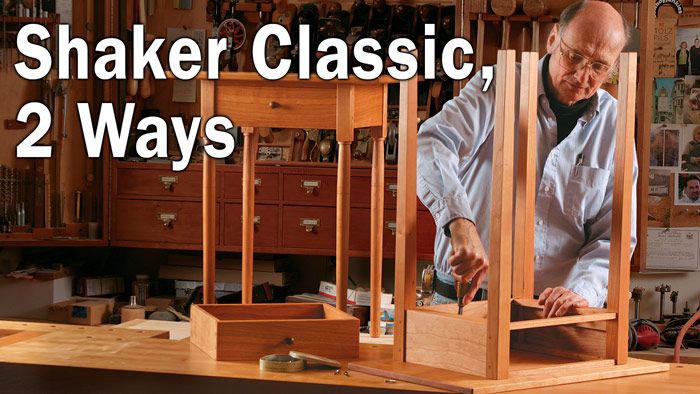
Not long ago, a couple ordered a set of cherry side tables from me, one for each side of their pencil-post bed. I based the design on a Shaker side table from Canterbury, n.H., although virtually every other Shaker community had similar designs. As a surprise (I don’t recommend this unless you are very familiar with your clients), I decided to make slightly different versions: one with square tapered legs, the other with turned tapered legs.
The overall design is a basic, timeless one that can move from bedroom to living room. But notice how the simple leg change alters the whole feel of the table. Tweaking the dimensions or shapes can make a big difference in the look of a piece of furniture. As far as difficulty goes, the table with tapered legs is a very good project to tackle if you’re a beginner, and the one with turned legs adds a bit of a challenge. The rest of the construction is standard mortise-and-tenon joinery, a dovetailed top rail, and a dovetailed drawer. I start with the legs, move on to the joinery, add the drawer, and finish.
Tackle the joinery: mortises, tenons, and a dovetail
Once the legs are finished (see “2 options for legs”), the construction is the same for both tables. The first step is to add the side and back aprons and drawer rails to the legs. I start with the mortises for the back and side aprons and the rail below the drawer. Then I cut the tenons on all of those pieces. The rail above the drawer is dovetailed into the top of the leg, and I tackle that after the mortises and tenons.
2 Options for Legs
The tapering jig to create these two-sided tapered legs is simple to make. Use a piece of plywood 4 in. to 6 in. wide and 3 in. to 4 in. longer than the leg. I mark the end of the leg to see the final dimensions and use those marks to position the leg on the ply-wood. Set the leg on the edge of the plywood with the portion to be tapered flush with the end and overhanging the edge. Then, trace around the leg and cut the leg area away freehand on the bandsaw. Once that’s done, screw that piece of plywood to a base piece and add hold-down clamps to keep the leg stock secure as you run it through the tablesaw.
After cutting the first taper, turn the leg 90° in the jig and cut the second one. The final step is cleaning up the tapers with a sander.
Mortise the legs—I have a dedicated slot-mortiser for this job, but a drill press and mortising chisel also will work. After you lay out the locations for the mortises, waste away the majority of the material on the drill press with a brad-point bit. Then you can use chisels to clean up the edges and ends.
Tenon the aprons and lower front stretcher—I cut the apron tenons on the tablesaw using a dado blade (see “Tenon Shootout” on p. 42 for more on this method). There are three different blade-height settings, one for each cheek and one for the top and bottom edges. By the way, the first cheek-cut height isn’t critical; it’s the second one that sets the final thickness and fit of the tenons. Also, on legs this small I try to maximize the length of the tenons, so I do end up mitering them.
I cut the lower front-rail tenons the same way as I cut the apron tenons. Then I use the shoulder-to-shoulder measurement of that piece to mark out the dovetail shoulders for the upper rail.
Dovetail the upper front rail to the legs—Once I have dry-fitted the three aprons and the bottom rail, I lay out the dovetails on both ends of the top rail, cut them with a handsaw, and refine them with a chisel. On the tablesaw, I skim a small rabbet on the underside of the dovetail, which creates a shoulder and helps locate the dovetail on the leg. Once that’s done, transfer the dove-tails to the tops of the front legs, using a knife. A small router with a 1⁄8-in. or 1⁄4-in. bit takes out most of the waste material. Use a chisel to clean the corners.
Glue up the bases and add runners, kickers, and spacers
Before adding the runners and kickers, sand the legs, aprons, and rails to P320-grit and glue the
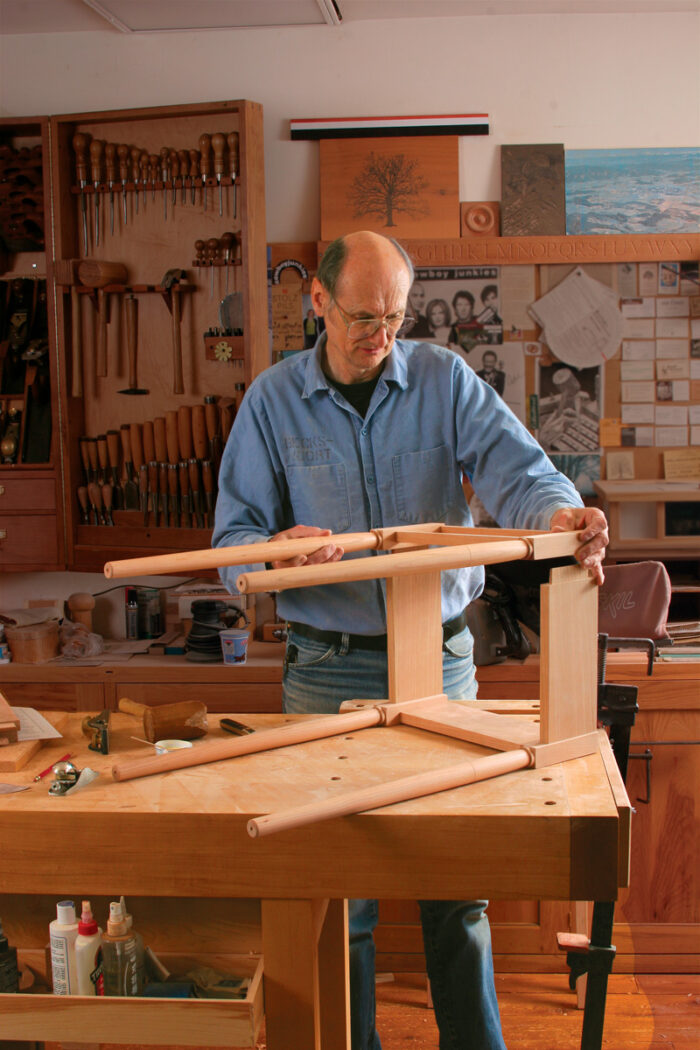
bases together. Begin by gluing the front legs to the rails and the back legs to the back apron in two separate assemblies. Once they are dry, add the two side aprons as a final assembly. And once that is dry, you can glue in the runners and kickers.
The drawer runners and kickers (a pair on each side of the drawer) are the same size and shape, simply a strip of wood notched to fit between the front and back legs. The runners sit below the drawer sides and provide the track that the drawer runs on while it moves in and out of the side table. A kicker is a strip of wood that is placed above each drawer side to keep the drawer from tipping down as it is opened and closed. In addition, I use the kicker to screw the top in place. Also, because the sides are inset from the legs, I glue in a spacer just above the runner. This spacer keeps the drawer from tilting left or right.
There is no joinery involved in adding the runners and kickers; they are simply cut to fit the interior, then glued and clamped in place, flush with the top and bottom of the aprons and rails. Trim the spacers perfectly flush with the inside faces of the legs.
Hand-cut dovetails in the drawers
The drawer fronts are cut to fit the openings. I make my fronts 3⁄4 in. thick, the back 5⁄8 in. thick, and the sides 1⁄2 in. thick. I make the back a little thicker than the sides for three reasons: First, thinner sides make the drawer appear more graceful, and you’ll seldom pull it all the way out to see the thickness of the back. Second, the added thickness gives a bit more glue surface to the dovetails, resulting in stronger joints on all four corners. Finally, it allows a solid bottom (not plywood) to expand and contract while remaining hidden under the back.
I cut half-blind dovetails in the front and through-dovetails in the back, cutting the tails first. I make the drawer bottoms from resawn, book-matched stock and secure them with a screw and slot in the back to allow for seasonal movement.
I turn the mushroom-shaped knobs on the lathe (see “Authentic Shaker Knobs,” FWW #196).
Screw the top in place
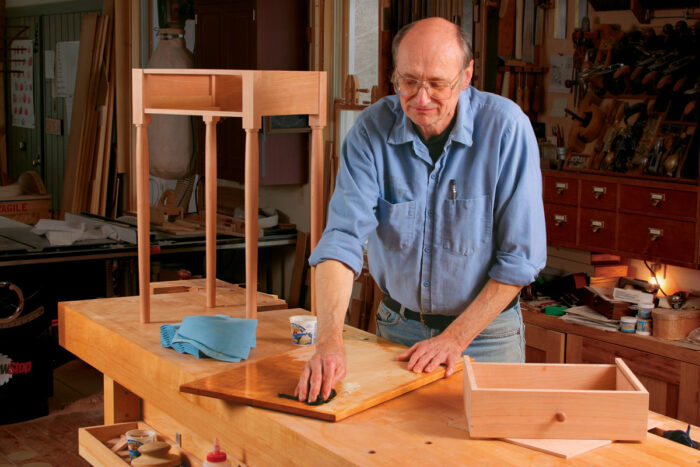
Last, I edge-glue the 3⁄4-in.-thick top, cut it to size, sand it, and use the tablesaw to add a slight bevel to the underside. With the top facedown, I center the base (11⁄2 in. front and back, 4 in. on the sides) and drill three countersunk holes through each of the drawer kickers (one in the center, one at either end) to screw the base to the top. I made the end holes oval-shaped to allow for wood movement.
I give the tables three coats of an oil finish. The first coat is straight Danish oil and the next two coats are a ratio of two parts Tried & True Varnish oil and one part spar varnish. I use only wax on the drawer runners, spacers, kickers, and drawer sides and bottom, to help them run more smoothly.
Download the plans for this table from the Digital Plans Library. Plus, browse 100+ other plans available for members only.
From Fine Woodworking #210
Fine Woodworking Recommended Products

Sketchup Class

Drafting Tools

Blackwing Pencils



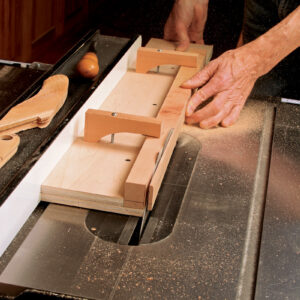
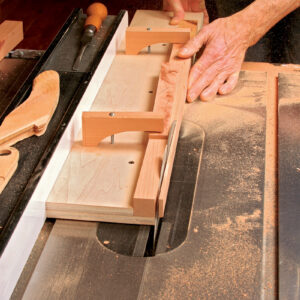
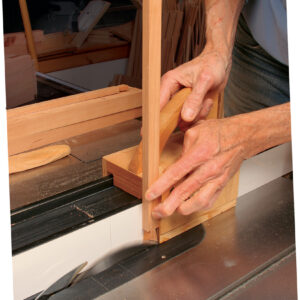
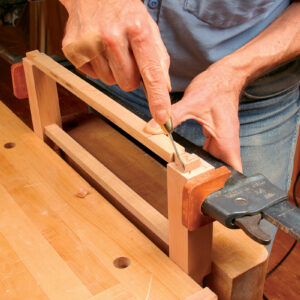
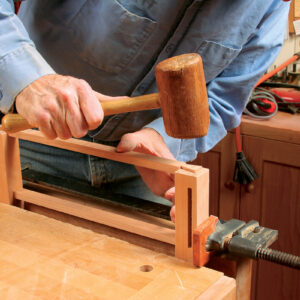
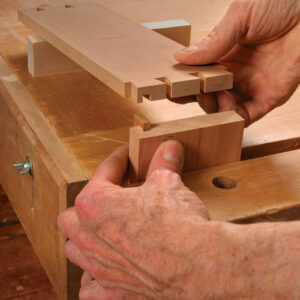
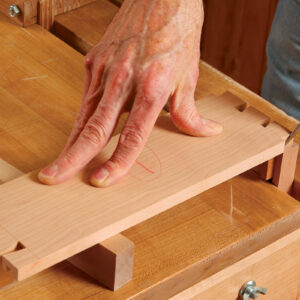







Log in or create an account to post a comment.
Sign up Log in